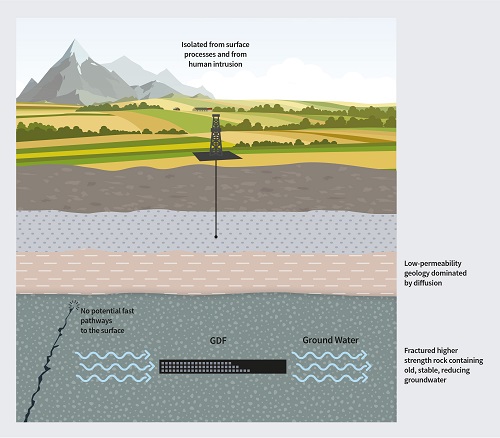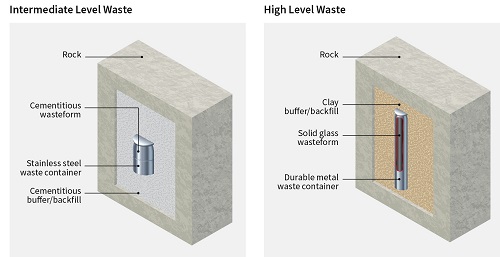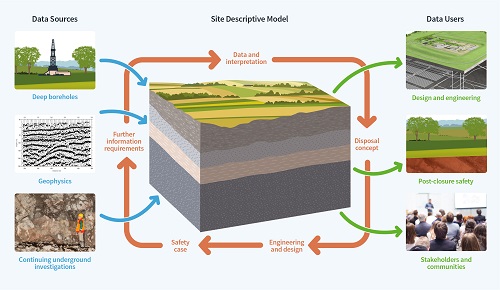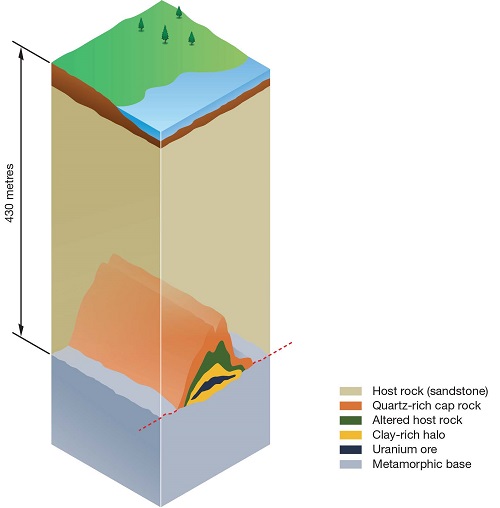Jonathan Turner on a major UK infrastructure project with which geoscientists will be engaged for many years to come
Turner J., Deep geological disposal of the UK's radioactive waste: Geoscience, technology and society. Geoscientist 30 (8), 10-15, 2020
https://doi.org/doi: 10.1144/geosci2020-104, Download the pdf here
The UK has had a nuclear industry since 1945, which means we have been accumulating radioactive waste for more than 70 years. How we safely dispose of that waste is one of the nation’s most important challenges, requiring a unique blend of science, technology, social science, design and engineering.
Radioactive Waste Management Limited (RWM), a subsidiary of the Nuclear Decommissioning Authority, is engaged in delivering one of the largest environmental projects ever undertaken in the UK: a deep geological disposal facility (GDF) in which higher activity radioactive waste from England and Wales will be disposed of permanently.
 Many of the core geoscience skills developed by mainstream Earth sciences degree courses are central to radioactive waste disposal whilst others are taught less widely. This article aims to give a flavour of the range of geoscience skills needed to support the GDF programme as well as providing an introduction to some of the ‘whats’ and ‘whys’ of radioactive waste disposal.
Many of the core geoscience skills developed by mainstream Earth sciences degree courses are central to radioactive waste disposal whilst others are taught less widely. This article aims to give a flavour of the range of geoscience skills needed to support the GDF programme as well as providing an introduction to some of the ‘whats’ and ‘whys’ of radioactive waste disposal.
Left: Figure 1 - Underpinning principles of deep geological disposal: long-term containment of radionuclides, and isolation of the radioactive waste from natural surface processes and from future generations mining into it. The geological configuration depicted here is of Higher Strength Rocks overlain by a potentially sealing succession of Lower Strength Sedimentary Rocks, including claystone. It is just one example of several configurations that could be suitable for GDF construction.
What are the main functions of a geological disposal facility?
The nature of radioactive decay means that higher activity waste needs to be contained for a sufficient period of time to allow it to decay to background levels. Though this is a long time period from the human perspective, it is geologically quite short. A GDF is highly engineered such that it does not require any post-closure monitoring; its underpinning functions are to contain radioactive materials deep underground for hundreds of thousands of years such that they cannot migrate to the surface, and to isolate radioactive waste from surface processes, such as continental glaciations and sea level change, and from future generations mining into it (Fig. 1).
What is the nature of radioactive waste?
The UK’s long involvement in commercial nuclear power, and medical and defence applications of radioactivity, means we have a diverse range of legacy waste to manage. There are two broad categories of higher activity waste – relatively small volumes of heat-generating, high-level waste created by the reprocessing of spent nuclear fuel, and larger volumes of cooler, intermediate-level waste.
The GDF inventory also includes a small amount of low-level waste which is not suitable for disposal at existing surface facilities. This material presently exists either in storage, or within facilities around the country (Fig. 2) which are operating today but will need to be dismantled and their waste managed. As a permanent disposal solution requiring no ongoing human intervention, a GDF relieves the enduring cost burden of ensuring the safety and security of storing legacy higher activity waste in interim storage facilities above ground.
RWM must also be prepared to manage wastes that may arise in the future, such as unreprocessed spent fuel and the waste that would arise from a future nuclear build programme of up to 16 gigawatt electrical. RWM’s plans make provision to dispose of up to 750,000m3 of packaged higher activity waste, equivalent to a single cube whose sides are equivalent to the height of the Queen Elizabeth Tower (Big Ben). As well as the permanent disposal of legacy higher activity waste a deep geological disposal programme therefore allows the UK to prepare for the responsible future management of waste arising from proposed new nuclear energy developments.
Government policy
 Right: Figure 2 - Locations of sites across the UK where radioactive waste is presently stored
Right: Figure 2 - Locations of sites across the UK where radioactive waste is presently stored
Radioactive waste is a devolved issue. Scottish policy is that the long-term management of higher activity waste should be in near-surface facilities located as close as possible to the site where the waste was produced.
UK and Welsh Government policy for geological disposal of higher activity radioactive waste has established a consent-based process for identifying potential GDF sites. Successful GDF delivery requires three key ingredients: a willing community, a suitable site including its deep geology, and suitably packaged waste. Public engagement is a central component of RWM’s work and represents a significant challenge, not just the issues surrounding “nuclear” but also building a broad understanding of the evolution of the GDF environment up to a million years after its closure.
Since the current site selection process launched in late 2018 (early 2019 in Wales) RWM has been engaging with the public and a wide range of other stakeholder groups to raise awareness and build a greater understanding of the issue of long-term radioactive waste management. This engagement is aimed at opening up more detailed local discussions with communities that may be interested in finding out more about what hosting a GDF could mean for their local area. RWM is agnostic about the ‘best geology’ and the ‘best site’ and will not be in a position to start evaluating in detail the suitability of potential sites until strong community partnerships are established.
National Geological Screening
RWM has produced a suite of National Geological Screening information, underpinned by detailed British Geological Survey reports, that gives communities a flavour of how their local geology could contribute to the safety of a GDF. A diverse range of geological settings could be suitable for GDF construction and illustrative concepts have been developed for various disposal methods. They are based on a representative range of host rock types and their geotechnical properties.
As well as helping to raise awareness, the National Geological Screening provides one of the most comprehensive compilations of UK subsurface geology for general use. The information is based on public domain data and is supported by bespoke maps, tables and explanatory videos that describe the geology of the 13 British Geological Survey regions within England, Wales and Northern Ireland. Note that while the Northern Ireland Executive jointly published the 2014 White Paper that commissioned the National Geological Screening, they have not produced any final policy on GDF siting and there is no active siting process taking place in Northern Ireland.
The screening work is described under the headings: Rock Type, Structure, Hydrogeology, Natural Processes (mainly ice ages and earthquakes) and Resources. The National Geological Screening maps include the inshore area, comprising Crown Estate land up to 22km from the coast, beneath which a GDF could be accessed via a drift extending from an onshore surface site.
Characteristics of potential host rocks for a geological disposal facility
 Left: Figure 3 - Cutaways showing typical elements of the engineered barrier system for intermediate level waste (left) such as irradiated graphite, and high-level waste (right) such as vitrified reprocessed fuel
Left: Figure 3 - Cutaways showing typical elements of the engineered barrier system for intermediate level waste (left) such as irradiated graphite, and high-level waste (right) such as vitrified reprocessed fuel
In keeping with deep geological disposal programmes around the globe, RWM identifies three broad categories of potential host rock: i) lower strength sedimentary such as the Middle Jurassic claystones in which France and Switzerland intend to construct their GDFs, ii) rock salt like the Permian evaporites in which the Waste Isolation Pilot Plant has operated in New Mexico since 1999, and iii) higher strength rocks such as massive and slaty metasediments, and the Archaean granitoids in which the Finnish GDF is being constructed, with the Swedish facility proposed in similar rock.
The National Geological Screening maps show where the three host rock types are expected to be present in the depth range 200m-1000m; an interval that must avoid the effects of glacial erosion and is deeper than potable groundwater resources. The maps also show major structures such as zones of folding and faults with throws of 200m or more, and areas that have been intensively exploited for resources (e.g. coal, metals, oil and gas). Many coal mines and oil and gas fields are places where boreholes, shafts, ramps, and underground tunnels interfere with natural groundwater systems, thus creating potential pathways to the surface from depth. Consequently they are less likely to be suitable places to construct a GDF.
Rock salt and lower strength sedimentary host rocks are relatively weak and therefore present a greater engineering challenge during the operational life of the GDF. They are characterised by permeabilities that are very low (claystone) or near-zero (salt) such that radionuclides in groundwater and gas move only very slowly, mainly by diffusion. Salt and claystone therefore provide an effective barrier to the migration of potentially harmful radionuclides.
Higher strength rocks are stronger and therefore easier to operate in, but they often contain networks of interconnected fractures that can provide pathways for movement of groundwater and gas. In the event that RWM is engaged in community partnerships in areas that include fractured higher strength rocks, methods have been developed to describe and model fracture systems that are similar to those applied by the oil and gas industry to characterise fractured reservoirs.
Site descriptive models
 Right: Figure 4 - Site Descriptive Model (SDM) represented schematically by the 3D visualisation in the centre. Cycles of data acquisition-concept selection-design and safety cases-information requirements are represented by the brown arrows surrounding the SDM. Blue arrows show the main sources of data that inform the SDM with the green arrows denoting its main users.
Right: Figure 4 - Site Descriptive Model (SDM) represented schematically by the 3D visualisation in the centre. Cycles of data acquisition-concept selection-design and safety cases-information requirements are represented by the brown arrows surrounding the SDM. Blue arrows show the main sources of data that inform the SDM with the green arrows denoting its main users.
A key component of RWM’s disposal concept is the multi-barrier system in which the natural geological barrier works together with engineered barriers (Fig. 3), such as the solid wasteforms, canisters, bentonite buffer, specially designed backfill materials, and plugs and seals. The design of the multi-barrier system is based on information obtained from detailed characterisation of site-specific geology. Site descriptive models of the near-surface, and deep geology and biosphere, will be based on data from surface mapping, airborne geophysics, seismic surveys and deep boreholes (Fig. 4). They will yield among the most highly resolved descriptions of the subsurface in the UK.
In some geological configurations, especially layered sedimentary sequences, bespoke seismic data tuned to optimise imaging at GDF depths will enable RWM to make detailed assessments of the structure and distribution of lithotypes, and even pore fluid types and elastic properties, before deep boreholes are drilled. For example, in Switzerland 3D seismic surveys were used to characterise the geology of the three sites now being tested with a campaign of deep boreholes.
The picture that emerges from geophysics will be augmented by information that can only be obtained from borehole samples, such as hydrogeochemistry (e.g. pH, EH, sulphides, oxygen, microbes), geotechnical and thermal properties, and groundwater flow tests. Throughout the construction and commissioning phases of the GDF programme, continuing underground investigations will lead to further refinement of the site descriptive model, testing the veracity of its predictions against observations.
The site descriptive models will therefore synthesise all the key information at each site, allowing RWM to satisfy regulators and other stakeholders of both the operational safety of a GDF and the long-term post-closure integrity of the multi-barrier system. Moreover the models will be a powerful tool for communicating progress with the site characterisation phase to the general public and to potential GDF host communities.
Analogues
 Left: Figure 5 - Cross-section through the Cigar Lake uranium ore body, northern Saskatchewan. High-grade ore is encased in a 1.3 billion year-old mudstone that has contained the radionuclides such that there is no trace of uranium contamination in the overburden.
Left: Figure 5 - Cross-section through the Cigar Lake uranium ore body, northern Saskatchewan. High-grade ore is encased in a 1.3 billion year-old mudstone that has contained the radionuclides such that there is no trace of uranium contamination in the overburden.
GDF delivery is an ambitious and challenging programme, envisioning some 150 years of site characterisation, construction, operation and decommissioning, and a post-closure safety case extending hundreds of thousands of years into the future. So it is natural to ask: “Has it been done before?”. Yes it has, by other industries – individual tranches of the GDF programme are comparable in scale and complexity to recent major infrastructure projects such as the Channel Tunnel and Queensferry crossing.
There are good examples from nature of the soundness of the general concept of isolating materials deep underground over geological time periods. Cigar Lake in northern Saskatchewan (Fig. 5) is the world’s largest high-grade (~20%) uranium mine. The ore is encased in a 1.3billion year-old mudstone yet with no trace of uranium contamination in the overburden or at the present surface. In oil and gas fields around the world, rock salt and low-permeability mudstones are implicated in trapping extensive columns of buoyant hydrocarbons in the deep subsurface for millions of years.
What are other countries doing?
Almost every nation that has made a decision on long-term management of its radioactive waste legacy has selected deep geological disposal as the preferred solution, and several are at variously advanced stages of delivering GDFs – in Sweden (SKB), Finland (Posiva), France (ANDRA), Switzerland (Nagra) Canada (NWMO), Japan (NUMO) and others around the world. In the USA the Department of Energy’s Waste Isolation Pilot Plant in New Mexico has operated since 1999.
Sweden and Finland have relatively small and uncomplicated inventories dominated by spent fuel. Both countries are seeking to develop GDFs at depths of some 500m in fairly sparsely fractured granitoid rocks. Their current proposals are based on disposal concepts in which fuel assemblies are hermetically sealed in 5cm-thick copper canisters up to 5m long, with a post-closure design life of thousands of years. The canisters will be emplaced in 50cm-thick sleeves of bentonite that swell during post-closure re-saturation, creating a low-permeability buffer that isolates the copper canisters from minor amounts of groundwater within the Archaean granitoid host rocks at these sites. SKB and Posiva have invested considerable effort characterising groundwater flow through fracture networks in the vicinity of their proposed GDFs, and understanding how the fractures behave in the in situ stress field.
In France and Switzerland, site characterization programmes are focused on very low permeability Callovian-Oxfordian mudstone host rocks such as the Swiss Opalinuston. In France, ANDRA presently operate a 500m-deep underground rock laboratory at Bure in the south-eastern Paris basin, close to where they are seeking a licence to construct a GDF. French law requires ANDRA to be able to retrieve the waste after it has been disposed of. Consequently they have developed a bespoke disposal concept in which robots will emplace carbon steel canisters nose-to-tail within 100m-long horizontal tunnels, and which are capable of being extracted decades later.
In the Alpine foredeep of northern Switzerland Nagra have acquired and interpreted high-quality 3D seismic data in three areas. In 2019 they commenced a deep drilling campaign such that in the next few years they will be in a position to recommend to Swiss government their favoured site for a GDF.
In the USA the Waste Isolation Pilot Plant is the only operating deep geological disposal repository for radioactive waste and has been receiving low heat-generating transuranic materials from US defence programmes since 1999. The facility was closed between 2014-2017 following a salt-haul truck fire in the mining operations, and an unrelated waste packaging fault within a disposal area caused by incorrect packaging of waste at source. Waste is transported by specialist trucks from across the country and is transferred underground for disposal only a few days after arriving at the plant. The facility is constructed beneath the Permian basin of south-eastern New Mexico within flat-lying beds of halite and potash salts more than 550m thick. Salt creates an extremely dry environment devoid of groundwater and its tendency to creep under deep crustal pressures means that after the vaults have been decommissioned the halite closes in and seals the waste.
A new opportunity for UK geoscience
Deep geological disposal of radioactive waste is one of the UK’s most challenging major infrastructure programmes with direct bearings on the current debate on our energy future and how we can safely manage existing nuclear risks. The programme to deliver a GDF will evolve to become one of the prime investments in the UK subsurface and it has the potential to capture the national imagination and build public confidence in responsible stewardship of the subsurface. The GDF programme offers exciting possibilities for the career development of current and future generations of geoscientists.
Jonathan Turner is Chief Geologist at Radioactive Waste Management Limited.